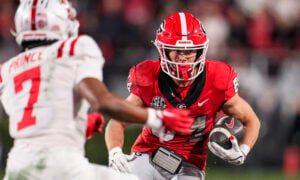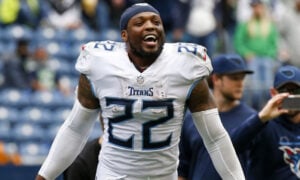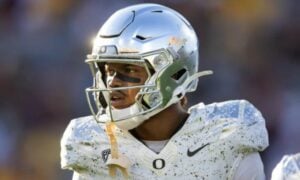Dynasty Post Draft Analysis: 32 Teams, 32 Questions – Part Two
Editor’s Note: This is part two of a four-part series.
The 2020 NFL Draft came and went with a lot of energy, excitement and certainly a new look no one could have foreseen just a few months ago.
Despite the uncertainty imparted by the COVID-19 pandemic, it was the most interesting and engaging draft we’ve had yet. I can’t ever remember watching every round unfold with as much interest as the round before it, but that is exactly what happened. Being brought into the homes of the players, coaches and GM’s added a personal element to the broadcast that hasn’t been present before. And as for the draft itself, what a great one it was!
The 2020 NFL Draft had all the elements of 2014 and in the end, at least in my estimation, surpassed it to become my favorite draft of all-time, not only for the new process but in the depth and talent of this year’s rookie class. There was talent, intrigue and mystery at every position and with every selection and, like any good novel, ample amounts of twists, turns and subtle plot lines to keep things interesting from beginning to end.
Now that the dust has settled and each rookie has a new home, we need to survey the landscape to determine what opportunities exist, what the future holds for the teams and what questions remain. All selections are not created equal and as this was a very deep draft class. Dynasty players need to spend extra time getting these selections correct so as not to waste their precious draft capital. So join me here as I spin you around the league through all 32 teams, in two parts, to look at what I believe to be the primary questions for the upcoming season and beyond. Following each player in parentheses, including rookies, will be his DLF positional ranking. For specific rookie rankings, please consult our rookie rankings.
One note before we begin. As is always the case, the opinions here are my own. I spend a lot of time watching tape, reading proven NFL expert analysis and forming my own conclusions about talent to predict potential at the next level for the rookies and veteran players. In my fantasy activities I focus on ignoring hype, bold calls and meaningless data and, instead, focus on trends, production and metrics I feel have the most impact without a level of subjectivity. In everything I do, my objectivity is my calling card whether it’s in the court of popular opinion or if I’m by myself on an island.
Let’s continue with the AFC.
AFC Part One
Baltimore
Can Lamar Jackson do it again?
Lamar Jackson (QB2) had an MVP season by passing for over 3,100 yards, and posting 36 touchdowns to only six interceptions. But he didn’t stop there. He also rushed for an outlandish 1,200 yards and another seven scores. No wonder Cam Newton can’t seem to find his Superman cape.
Heading into 2020, the Ravens had the luxury of using the NFL Draft to consider a best player available approach (BPA) if desired and they appeared to do just that. Without glaring holes across offense and defense, it’s an enviable position to be in, especially in that the team held ten draft picks, including what ended up to be four third-round selections. If there was one primary area of of concern, it may have been at the receiver position, where the young corps was a bit slow to develop. Still with plenty of upside at the position, the team selected rookie Devin Duvernay (WR75) in the third round and added the recently-rising James Proche (unranked) from SMU in the sixth round. But the highlight pick was J.K. Dobbins (RB12), who may need to sit a year while the aging Mark Ingram receives an opportunity to build on a success 2019 campaign. Miles Boykin (WR78) should start on the outside, 2019 rookie Marquise Brown is hoping to shake off an injury-plagued first year and should see an increase in production and stellar tight end Mark Andrews is a good bet for a top-five finish at the position.
There’s little reason to expect a reduction in passing production from Jackson and, in fact, growth at receiver should provide some upside. Don’t expect another 1,200 yards rushing in 2020 as the Ravens seek to keep Jackson healthy though he’ll be a frequent visitor outside the pocket using his feet to gain chunk yardage.
Dobbins continue to rise on draft boards though dynasty coaches will need to be patient for at least a year. That’s a long time to wait and it will keep him lower in the rankings but I’ve seen him drafted ahead of D’Andre Swift now in two recent drafts. Fade Justice Hill and Gus Edwards due to Dobbins’ presence.
Buffalo
Can the Bills improve their passing attack?
The easier choice may have been to highlight the rushing attack with youngsters Devin Singletary (RB27) and incoming rookie Zack Moss (RB36). But without an improved passing attack, it’s hard to project much more from the Bills in 2020, though they did make some noise in 2019.
To be honest, I grew tired this off-season hearing about John Brown‘s (WR61) resurgence. Like Detroit with running backs, I have deemed Buffalo’s passing attack as where receivers go to die. This may be overly harsh because the aforementioned Brown finished 2019 as the WR15 and even Cole Beasley (WR110) finished as the WR29. Pause and look at those rankings again given their production. Yes, Brown finished as a WR2 and to that I would ask, “Are you willing to put your draft capital on the line and select him as the WR15?” Not taking anything away from Brown but welcome to WR3-land – at best. I would consider Brown as a WR4 but I’m more likely to allow another coach to take the risk. I’m obviously not alone given the rankings.
The primary question actually centers on newcomer Stefon Diggs (WR22), following an obviously bitter-ending in Minnesota. Diggs was just starting to grow on me as a receiver and then he lands in Buffalo. To that I say, “No thank you” but it’s a receiver corps built for a strong-armed scrambling quarterback like Josh Allen (QB7). The Bills don’t carry proven and productive size at receiver, but Diggs, Brown and Beasley could provide a speed dynamic which may pay dividends in 2020, just not on my roster. I’m still fading all Buffalo receivers until I see consistency in production.
At running back, the Bills tabbed Moss as their Frank Gore replacement during the NFL Draft. Moss isn’t long on speed nor does he possess significant lateral agility but he’s good between the tackles, can get ‘skinny’ and isn’t afraid to lower his shoulder. A little bit like Clyde Edwards-Helaire, he’s talked about favorably in NFL circles. He just has that NFL-style of game. Moss is gaining popularity as a second-round dynasty rookie selection and while his success will come at the expense of sophomore Singletary, it’s a committee backfield that could be effective. I don’t like either as RB2-upside backs but Singletary as an RB3 is plausible with Moss having some short-yardage appeal. An injury to either will provide immediate upside to the other.
As far as rookie receiver selections Gabriel Davis (WR109) and Isaiah Hodgins (Unranked), it seems clear the Bills are trying to add a size dynamic and I’m not overly high on either.
Cincinnati
Is Joe Burrow the answer?
The Bengals finished 2019 with a mediocre passing attack, ranked 18th in the league with 228 yards per game, but finished a dismal 30th in the league in points per game (17.4) according to TeamRankings.com. After years of sub-optimal performance from Andy Dalton (QB39), the team finally landed their new face of the franchise Joe Burrow (QB13) with the first first overall selection in 2020. But can the poor performance in 2019 be hung on the red-head of Dalton behind PFF’s 30th ranked offensive line?
Running back Joe Mixon (RB7) nearly rushed for a career-high in 2019 when he amassed 1,137 yards on the ground via 278 totes – 31 yards shy of his 2018 mark. But his rushing touchdown total of five left much to be desired though he did score an additional three as a receiver, good for a combined eight touchdowns overall, only one short of his 2018 total. It was obvious the offensive line was struggling.
The team also added rookie receiver Tee Higgins (WR39) with the first selection in the second round, further bolstering a receiving corps currently led by aging and oft-injured veteran A.J. Green (WR55). Tyler Boyd (WR26) is the clear favorite of the group in dynasty and has assumed the WR1 role while Green is in his last year and likely will not return to the team in 2021. Higgins should see field time immediately with a good camp, pushing for playing time in three-wide formations out of the slot, relegating 2017 first-round selection John Ross (WR75) as a failed speed experiment and a release candidate following the season.
Burrow will breathe new life and energy into the team and fan-base but without significant offensive line improvement, the Bengals may be looking at another high selection in 2021.
Denver
Is an offensive surge in store for the Broncos?
On the surface, all arrows are pointing straight up for the Broncos. Quarterback Drew Lock (QB18) looked the part in five games to end the season and Denver spent significant draft capital on offensive weapons during the NFL Draft. The team also added running back Melvin Gordon (RB21) to pair with Phillip Lindsay (RB34), relegating Royce Freeman (RB58) to trade candidate status.
During the draft, the team added Jerry Jeudy (WR19) in the first round, KJ Hamler (WR68) in the second, tight end Albert Okwuegbunam (TE39) in the fourth and receiver Tyrie Cleveland (unranked) in the seventh. Already sporting young playmakers at receiver with Courtland Sutton (WR15) and Noah Fant (TE6) and it’s understandable if Broncos fans are giddy at the prospects for this young group. I’m looking for this group to take a big step forward in 2020 and am still very high on Jerry Jeudy. I don’t like his situation as much as CeeDee Lamb‘s (WR17) in Dallas but he has star potential. For the record, I’m not as high on Sutton as most others and will need to see a good 2020 before elevating him further in my rankings. But for the aforementioned back Royce Freeman and slot receiver DaeSean Hamilton (unranked), it looks like it’s game over at Mile High.
Houston
How will the Texans replace DeAndre Hopkins?
most would agree the trade of Hopkins was the single most stunning moment in this past off-season. While there had been talk of discord between Hopkins (WR4) and Head Coach Bill O’Brien, I still don’t think anyone saw it coming. Houston shipped away one of the top receivers in the NFL and replaced him with fading running back David Johnson (RB29) and pedestrian receiver Randall Cobb (WR94). How will the Texans replace Hopkins’ presence?
The short answer is, they can’t. The trio of starting receivers are serviceable at best but lack star-power. The running game was an issue and a healthy Johnson could pay immediate dividends but even quarterback Deshaun Watson (QB4), an MVP-caliber player currently in his prime, is going to have trouble finding consistency in 2020. The team did add off-the-radar receiver Isaiah Coulter (WR111), one of my favorite sleepers at the position, but he’s raw and will need time to develop. Given his size-speed dynamic, however, I like Coulter’s potential in this offense.
I was excited to see what the Texans could be in 2020 should they have added one more receiver and used the free agent market to add a back like Melvin Gordon (RB21) or even Devonta Freeman (RB62). Instead, they’ve heaped even more pressure onto Watson and will expect him to paint a Picasso with finger paints.
Indianapolis
Will the retooled offense pay immediate fantasy dividends?
I have to admit I feel bad for quarterback Jacoby Brissett (QB43). He didn’t have much to work with and while it’s said the team still values him at the position, that didn’t stop them from adding Philip Rivers (QB32) for what could be one year. Then the team scored two huge potential play-makers in the NFL Draft by selecting Michael Pittman Jr. (WR42) and Jonathan Taylor (RB10) early in the second round on day two of the draft. I’m going to focus on the two rookies here as they are certainly the most polarizing topics on the offense.
Pittman has WR1 ability but is very raw. I’m not ready to project him as the savior big-receiver the Colts need though he sure does look the part. Physically he’s the total package and he’s an immediate week-one starter without question. He’s trending up as a second-round rookie selection in dynasty drafts and for good reason.
The topic of Jonathan Taylor is a more interesting study, especially in that I’m on an island with my ranking. First, I love his size, speed and ability to hit the hole with his shoulders squared and good leverage. There’s no questioning his physical skills at the position as a runner and his production, in both yardage and touchdowns, backs that up. But beyond that, things begin to break down. Taylor ran behind the eighth best (PFF) offensive line in the nation which is common at Wisconsin. As the Head Coach has said in the past, it’s a staple of their recruiting profile. In 41 games, he fumbled a staggering 18 times, losing 15 of them. He was rarely utilized on third-downs and is poor in pass protection, though he has the size to potentially develop in this area. While he did improve his receiving statistics in his final year, he has a very poor drop rate of 16% of catchable passes.
Wisconsin has a long history of productive backs with very few productive at the next level. Those willing to risk a ‘speed -trap’ on Taylor must hope for Melvin Gordon while steering clear of Ron Dayne and Montee Ball. In short, Taylor is a fine looking specimen but he projects as a non-versatile, early-down-only back with significant technical flags. I’m in the minority – and I was with Trent Richardson as well. That all said, I’m rooting for Taylor as he’s easy to root for and if he can overcome the technical issues, he’s got fine potential.
The obvious fade call belongs to Marlon Mack (RB33), but before tossing him on the trash heap, realize he’s still only 24 years of age and in the last year of his contract. The Colts look like they will allow him to walk in free-agency and he’ll get another shot to be a starter in 2021. Until then, he’s going to be part of a running back committee and I won’t be surprised to see him split touches with Taylor.
I like what the Colts have done here and while I struggle to see them as a playoff team in 2020, it’s not out of the question depending on Rivers’ performance.
Kansas City
Is Clyde Edward-Helaire the 1.01 in rookie drafts?
The reigning Super Bowl champs are impressive on both sides of the ball and their late first round selection of running back Clyde Edwards-Helaire (RB9) should receive material touches from game one. The question is just how material will his touches be?
It’s a perfect fit for the diminutive (5’7/207) runner as head coach Andy Reid has experience with similarly styled backs and he’ll vie for material carries and receptions from week one. But as was the case with all the top backs in this draft, the landing spot was less than ideal from a ‘need’ and competition point of view. Veteran producer Damien Williams (RB45) still very much factors into the offense and the Chiefs have already mentioned it will be a committee approach. Expect Edwards-Helaire to see a bulk of passing down duties and be sprinkled in in early-down work as well depending on situation. Don’t count out Darrel Williams (RB89) near the ‘stripe’ and short-yardage situations.
As for sophomore runner Darwin Thompson (RB63), it’s hard to project a role for him as his skill-set is easily replaced by others on the depth chart. It’s not out of the question that it’s Thompson who sticks on the roster while Williams is released. Training camp will show us the future.
Los Angeles Chargers
Can the receivers produce without Philip Rivers under center?
The departure of Philip Rivers (QB32) portends frustration and inconsistency to come, at least in the near term. As evidenced by his dynasty ranking, Tyrod Taylor (QB38) isn’t being treated as the starter and while it’s only a matter of time before first-round quarterback Justin Herbert (QB21) takes the helm, the production of both Keenan Allen (WR14) and Mike Williams (WR44) would benefit with with the veteran under center. The latter statement being arguable, though, gives some indication of the near-term dynasty prospects of Allen, Williams and tight end Hunter Henry (TE5). The respective ADP’s of all these players is beginning to see the negative implications of the quarterback uncertainty, and for good reason.
Rookie selections Joshua Kelley (RB66) and the little-known receiver Joe Reed (unranked) both slide into upside situations, though neither projects highly. Kelley, for his part, does possess a low-upside three-down skill set and could see snaps as a change-of-pace to rising back Austin Ekeler (RB14). Aside from Ekeler, it’s safe to fade the entire offensive unit in the short-term.
Have thoughts or comments? Please share below and stay tuned for Part Three.
Follow me on Twitter: @DLF_Jeff
- Lineup Advice: Wrap-up, Thank You and Goodbye (TTFN) - January 1, 2024
- Lineup Advice: Week 17 – Championship Edition - December 26, 2023
- Lineup Advice: Week 16 – The “What is” Edition - December 19, 2023


































































